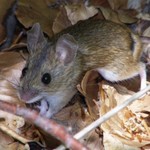
Jan. 22, 2013 — Researchers at the UPM have observed as voles are able to distinguish the acorns containing insect larvae from those that have not. This fact determines the dispersion and germination of acorns, and therefore the regeneration of forests of oaks. The Haedo de Montejo (Madrid) is a well preserved mixed forest of oak and beech. This is the place where researchers at the School of Forestry from the Universidad Politecnica de Madrid have carried out a research on scattering patterns of acorns for voles and found that when seed are attacked by insects, the fact that larva is or not inside of the acorn can modify the dispersion pattern, and consequently the regeneration of these types of forests.
The acorns are the fruits produced by oaks, holm oaks and cork oaks that perpetuate their species, move and colonize new places. They are autumnal fruits highly valued by wildlife because of its large size, its abundance and its high calorie lipid and carbohydrate. They are many animals interested in this fruit, some of them even before they ripen and fall into the ground.
This is the case of small beetles, the weevils (Curculio sp.), that lay their eggs inside the unripe acorns when they are still growing in the tree. These eggs hatch small larvae in worms shaped and feed inside the acorns without altering the external appearance of this fruit. After, the acorns fall into the ground and are reachable for the rest of animals that seek this fruit during the autumn days (wild boar, deer and mice, among others). When larva completes its development it drills a small hole out of the acorn and buries itself in the soil and, through the metamorphosis, becomes a new adult beetle.
Voles (Apodemus sylvaticus) are the main consumers of acorns and they hide this fruit during autumns in order to consume them in winter time. However, many acorns are forgotten in hiding places allowing them a better germination and consequently new trees. Surprisingly, the same acorn is usually moved or stolen by another vole, and achieving so a dispersal distance up to hundreds meters with respect to its mother tree and, therefore contributing to better movement of genes and a successful regeneration of these trees.
But, what do voles do with the attacked acorns by beetle larvae? There is not just an answer and depends on the fact that larvae has gone out or has stayed in the acorn. Acorns whose larvae had emerged out were rapidly rejected by voles barely touching, moving or storing them. These acorns were exposed on the ground and failed to thrive in a new tree.
However, those acorns in which the larva was still inside the fruit were moved and stored by voles. The study reveals that voles liked these larvae (rich in proteins) and feed on them, decreasing the harm produced by these worms over the acorns. Therefore, voles scattered and buried these acorns that finally contributed to generate new plants. The fact that the larva was still inside resulted definitive for the near future of the acorn, and therefore, the future of oak forests.
The nature maintains its compensation mechanisms and, an apparent harmful beetle can be attractive to voles that, at the same time, releases acorns from this enemy and help them to thrive thanks to its rich substance what allows them to survive winter and maintain this favorable relationship between vole and acorn.
These results reveal that we do not know ye the behavior of those ecosystems that we aim to preserve. The knowledge of multiple existing interactions among animals and plants are essential to know what should be protected and how our forests should be protected.



